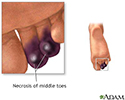Necrosis
Necrosis is the death of body tissue. It occurs when too little blood flows to the tissue. This can be from injury, radiation, or chemicals. Necrosis cannot be reversed.
When large areas of tissue die due to a lack of blood supply, the condition is called gangrene .
Gangrene
Gangrene is the death of tissue in part of the body.

References
Wallig MA, Janovitz EB. Morphologic manifestations of toxic cell injury. In: Haschek WM, Rousseaux CG, Wallig MA. Haschek and Rousseaux's Handbook of Toxicologic Pathology . 3rd ed. Waltham, MA: Academic Press, Elsevier; 2013:chap 4.
-
Meningococcemia on the calves - illustration
Meningococcemia is a life-threatening infection that occurs when the meningococcus, Neisseria meningitidis, invades the blood stream. Bleeding into the skin (petechiae and purpura) may occur. The tissue in areas may die (become necrotic or gangrenous). If the person survives, the areas heal with scarring.
Meningococcemia on the calves
illustration
-
Meningococcemia on the leg - illustration
Meningococcemia is a life-threatening infection that occurs when the meningococcus, Neisseria meningitidis, invades the blood stream. There is usually bleeding into the skin (petechiae and purpura), and the tissue in these areas may die (become necrotic or gangrenous). If the patient survives, the areas heal with scarring. This picture demonstrates more hemorrhage and little tissue death.
Meningococcemia on the leg
illustration
-
Meningococcemia associated purpura - illustration
Meningococcemia is a life-threatening infection that occurs when the bacteria, Neisseria meningitidis, invades the blood stream. Bleeding into the skin (petechiae and purpura) typically occurs and the tissue may die (become necrotic or gangrenous). If the patient survives, the areas heal with scarring.
Meningococcemia associated purpura
illustration
-
Necrosis of the toes - illustration
Necrosis is death of a portion of tissue or an organ in the body. Tissue death occurs when there is not enough blood supplied to the area, whether from trauma, radiation, or chemicals. Once necrosis is confirmed, it is not reversible.
Necrosis of the toes
illustration
-
Meningococcemia on the calves - illustration
Meningococcemia is a life-threatening infection that occurs when the meningococcus, Neisseria meningitidis, invades the blood stream. Bleeding into the skin (petechiae and purpura) may occur. The tissue in areas may die (become necrotic or gangrenous). If the person survives, the areas heal with scarring.
Meningococcemia on the calves
illustration
-
Meningococcemia on the leg - illustration
Meningococcemia is a life-threatening infection that occurs when the meningococcus, Neisseria meningitidis, invades the blood stream. There is usually bleeding into the skin (petechiae and purpura), and the tissue in these areas may die (become necrotic or gangrenous). If the patient survives, the areas heal with scarring. This picture demonstrates more hemorrhage and little tissue death.
Meningococcemia on the leg
illustration
-
Meningococcemia associated purpura - illustration
Meningococcemia is a life-threatening infection that occurs when the bacteria, Neisseria meningitidis, invades the blood stream. Bleeding into the skin (petechiae and purpura) typically occurs and the tissue may die (become necrotic or gangrenous). If the patient survives, the areas heal with scarring.
Meningococcemia associated purpura
illustration
-
Necrosis of the toes - illustration
Necrosis is death of a portion of tissue or an organ in the body. Tissue death occurs when there is not enough blood supplied to the area, whether from trauma, radiation, or chemicals. Once necrosis is confirmed, it is not reversible.
Necrosis of the toes
illustration
Review Date: 8/14/2015
Reviewed By: Linda J. Vorvick, MD, Medical Director and Director of Didactic Curriculum, MEDEX Northwest Division of Physician Assistant Studies, Department of Family Medicine, UW Medicine, School of Medicine, University of Washington. Also reviewed by David Zieve, MD, MHA, Isla Ogilvie, PhD, and the A.D.A.M. Editorial team.




